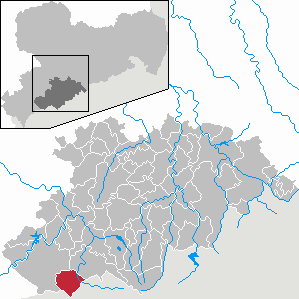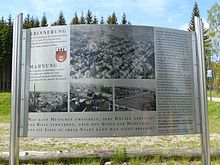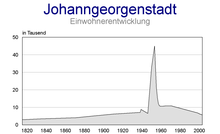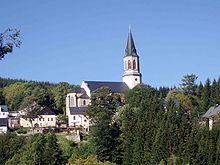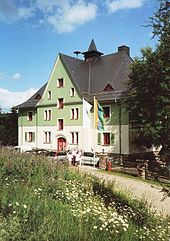Johanngeorgenstadt
| coat of arms | Germany map | |
|---|---|---|

|
Coordinates: 50 ° 26 ' N , 12 ° 43' E |
|
| Basic data | ||
| State : | Saxony | |
| County : | Erzgebirgskreis | |
| Height : | 780 m above sea level NHN | |
| Area : | 29.58 km 2 | |
| Residents: | 3897 (Dec. 31, 2019) | |
| Population density : | 132 inhabitants per km 2 | |
| Postal code : | 08349 | |
| Area code : | 03773 | |
| License plate : | ERZ, ANA, ASZ, AU, MAB, MEK, STL, SZB, ZP | |
| Community key : | 14 5 21 320 | |
| LOCODE : | DE TWH | |
| City structure: | 12 districts | |
City administration address : |
Eibenstocker Strasse 67 08349 Johanngeorgenstadt |
|
| Website : | ||
| Mayor : | Holger Hascheck ( SPD ) | |
| Location of the city of Johanngeorgenstadt in the Erzgebirge district | ||
Johanngeorgenstadt is a mountain town in the Saxon Erzgebirgskreis . It is located in the Western Ore Mountains directly on the border with the Czech Republic .
The city was founded in 1654 as a settlement of exiles of Bohemian Protestants and has a long mining tradition that began with the mining of iron and tin . Martin Heinrich Klaproth received samples of pitchblende from here , in which he was able to isolate the element uranium for the first time in 1789 .
After the Second World War , Wismut AG operated an intensive and sometimes ruthless mining operation between 1946 and 1958 , which had a lasting impact on the cityscape. So mountain damage resulted in the ordered demolition of almost the entire old town.
From a touristic point of view, the place is called the "City of the Schwibbogen ".
geography
Geographical location
The city extends mainly on the eastern slope of the almost 900 m high Fastenberg at the confluence of the Breitenbach, which partially forms the border with the Czech Republic, into the Schwarzwasser . The next higher mountains in the vicinity of the city are the 1019 m high Auersberg , the 1043 m high Blatenský vrch ( Plattenberg ) and the 913 m high Rabenberg .
Neighboring communities
Bordering communities are Breitenbrunn , Eibenstock and Potůčky .
City structure
Johanngeorgenstadt consists of the districts of Altstadt (popularly known as Sockendorf ), Mittelstadt, Neustadt, Schwefelwerk , Jugel (Ober- and Unterjugel), Henneberg , Wittigsthal , Pachthaus , Heimberg (with Külliggut), Steigerdorf (with Haberlandmühle ), Steinbach and Sauschwemme . The former district of Neuoberhaus is now a reforested desert.
climate
Due to the altitude (the pass of the road to Neustadt is 892 m above sea level ), the winter with its long-lasting snow cover often extends for half a year, so that Johanngeorgenstadt is one of the snow-sure areas in Saxony. Winds of four to seven are not uncommon all year round, which led to the fact that the place developed into a summer resort in the late 19th century. Since the area there was referred to as Saxon Siberia in some publications in the 18th century , one of the nicknames of the city is Johannsibirsk .
history
On February 23rd, Jul. / March 5, 1654 greg. In Annaburg, Elector Johann Georg I of Saxony approved the establishment of Johanngeorgenstadt by Bohemian exiles expelled from the mountain town of Platten and the surrounding area at Fastenberg, directly on the Saxon border in the Schwarzenberg office . He determined that the new city should bear his name. The foundation stone was laid on May 1st . / May 11th 1654 greg. . After the expiry of the two free years granted in 1656, the Elector of Saxony left the state excise, shock and potion taxes to the city until the beginning of the 18th century because of the prevailing poverty. This made Johanngeorgenstadt "freye Bergstadt". In 1662, on the initiative of Abraham Wenzel Löbel, the Johanngeorgenstadt Mining Authority was established. In 1680, around 100 ore mines were counted in the city and its surroundings. The mining was of tin on silver extended. It peaked in 1716 and declined over the course of the 18th century.
In 1770 Johanngeorgenstadt was hit by an earthquake that was even reported in a newspaper in Augsburg:
"It is reported from Leipzig that an earthquake, but special damage, was felt in Bockau, Schneeberg, Johann Georgenstadt, Eybenstock and in the whole of the native region."
The great famine in the Ore Mountains in 1771/72 claimed around 650 lives in the city.
As early as 1651 a hammer mill was put into operation in today's Wittigsthal district and in 1828 the first functioning sheet iron mill in Saxony was built in the Haberlandmühle by the hammer master Carl Gotthilf Nestler (1789–1864) . In the 19th century, among other things, the production of ribbon lace and, from 1860, leather gloves began. On August 19, 1867, a devastating major fire destroyed 287 of the 355 houses in the urban area. Seven adults and five children were killed.
The first large ski jumping hill in Germany was built in 1929 near Johanngeorgenstadt. It was named Hans-Heinz-Schanze . During the Second World War, the hotel “Deutsches Haus”, built in 1901 by Oskar Puschmann as the “Henriettenhof” opposite the train station, served as a hospital. The hotel of the former owner Arthur Krautmann already belonged as an office building to the sheet metal factory "Wendler & Weiß" of the manufacturer Herman Wendler. There was also a satellite camp of the Flossenbürg concentration camp in the city , in which 1,200 concentration camp prisoners in Plant IV, formerly Box Möbelfabrik Heinz, of Erla Maschinenwerk GmbH (Leipzig) had to manufacture parts for fighter planes. Every week 20 to 30 of them died as a result of the poor living conditions. The satellite camp was evacuated on April 13, 1945 and the prisoners were driven on a death march towards Theresienstadt concentration camp . Between May and August 1945 the former camp was used as a prison again.
After the end of the Second World War, the known uranium deposits in Schneeberg and Johanngeorgenstadt became the starting point for the Soviet exploration work on uranium in Saxony for the Soviet nuclear weapons program .
In 1946, AG Wismut (from December 1953 SDAG Wismut) took over Johanngeorgenstädter Gruben from Sachsenz Bergwerks AG . With the establishment of object 01 , uranium mining began in the deposit at breakneck speed. In addition to the direct effects of mining on the site, there were also problems for the local economy. The AG Wismut occupied a large part of the factory halls of the Wittigsthal ironworks, as well as the factory building of the Wendler & Weiß company.
In the late summer of 1948, the Mühlbergsiedlung was laid out as a quarter for around 8,000 miners from the Wismut mines. Some of the barracks for this originally came from the prisoner-of-war camp Stalag IV B , from 1945 to 1948 the Soviet special camp Mühlberg on the Elbe .
Analogous to the resettlement campaign in Oberschlema , Wismut AG also urged Johanngeorgenstadt to resettle the residents of the old town and demolish the buildings there from 1951. At that time, the effects of mining on the old town of Johanngeorgenstadt were not foreseeable. In December 1951, a clearance zone with an area of about 90 hectares was established. The planned demolition affected a total of 431 houses with around 5,600 inhabitants, five larger businesses, 199 smaller businesses, 26 smallholders and almost all public facilities in the city. At the end of 1952 the clearance zone was specified again by those responsible. Only 412 houses were now affected.
Since there was no possibility of accommodating the resettlers in the vicinity of Johanngeorgenstadt, the decision was made to rebuild the new town. Construction on this project began on February 20, 1952. The first apartments in the Neustadt could be moved into on July 20, 1953. With the completion of the first apartment blocks in the new town, the evacuation of the old town was accelerated. 440 houses should now be cleared, as the boundaries of the area to be cleared have been changed again. By the end of 1956, around 3480 residents had been resettled. By reducing the size of the evacuation area, but also by the resistance of the affected residents, only 319 houses had been cleared and around 4,000 residents were relocated by the end of the action in 1957. After the houses were demolished, avenue trees were planted along the streets from 1960, while the forest, which was felled on a large scale in 2013, was reforested on the fallow land.
From 1952 to 1957 Johanngeorgenstadt formed its own urban district, then it was part of the Schwarzenberg district and later the Aue-Schwarzenberg district - today the Erzgebirgskreis.
During the GDR era there were over 40 holiday homes and company holiday camps in the city. For example, the Deutsche Reichsbahn maintained the “ Helmut Gansauge ” vacation home in Lease Street 21 with the Dresden civil engineering company .
The closure of numerous companies in the glove, textile and furniture industries, as well as mechanical engineering, which began in 1990, resulted in an enormous decline in the population, far below the pre-war level. This in turn resulted in the demolition of numerous vacant factory and residential buildings (especially in Neuoberhaus, Lachthaus, Mühlberg and the Mittelstadt, some of which were former barracks of the Wismut miners). One of the few cultural monuments in the city was also affected by the demolition measures in 2005: the building of the mountain magazine , which was built between 1806 and 1812 and was spared the great city fire in 1867, was demolished with the approval of the city council.
Due to the budget situation (9.7 million euros in debt, annual deficit of 600,000 euros (as of August 2011)), the Saxon Ministry of the Interior and Finance has been putting pressure on Johanngeorgenstadt since 2011 to give up its independence in order to get its financial problems under control to get. In addition to incorporation into the neighboring community of Breitenbrunn, Johanngeorgenstadt also brought into play a merger of all communities on the Auersberg , which, however, would hardly be practical in view of the long distances that would arise. Negotiations are being held with the neighboring municipality of Breitenbrunn as to whether an incorporation or a merger would be feasible.
Incorporations
- 1935: Jugel and Wittigsthal
- 1952: Steinbach
Population development
Development of the population (from 1955 December 31) :
|
1815 to 1946
|
1950 to 1976
|
1998 to 2007
|
since 2008
|
- Data source from 1946 to 1976 (except 1953): Statistical yearbooks of the German Democratic Republic
- Data source from 1998: State Statistical Office of the Free State of Saxony
Of the 5748 inhabitants on December 31, 2003, 2,751 were male and 2,997 were female.
Memorials
The grove of honor for the victims of fascism, which was laid out in the 1970s in the center of Mittelstadt on Eibenstocker Strasse, was removed immediately after 1990. What have been preserved are:
- Memorial plaque from 1965 on the ruins of the former furniture factory A. Unger road to the victims of forced labor of the satellite camp of Flossenburg
- Mass grave and memorial from 1950 in the cemetery for murdered Soviet prisoners of war and concentration camp inmates, as well as a memorial stone from 1966 for four named French forced laborers.
- Memorial stone in the courtyard of the former Pestalozzi-Gymnasium on Schwarzenberger Straße for the Nazi opponent Hans Friedrich , murdered by SA men in March 1933 .
Other memorial sites:
- A memorial stone for the victims of Stalinism with the names of the deceased was inaugurated on the market square in 1993.
- Memorial plaque Mühlbergsiedlung: In 2005, a plaque was erected on Pferdegöpel 1 for the now demolished Mühlbergsiedlung, whose barracks came from the POW camp Stalag IVB, which was the Soviet special camp Mühlberg from 1945 to 1948. The plaque commemorates the dead in the camps and the people of Johanngeorgenstadt imprisoned there.
- List of stumbling blocks in Johanngeorgenstadt
politics
City council
Since the municipal council election on May 26, 2019 , the 14 seats of the city council have been distributed among the individual groups as follows:
- SPD : 5 seats
- Voting Association for Economy and Commerce Johanngeorgenstadt (WGJ): 4 seats
- CDU : 3 seats
- LEFT : 2 seats
coat of arms
The city coat of arms comes from the time the city was founded.
Blazon : “Divided by silver over red; above three red buildings with towers, below a small silver shield with black mallets and irons inside. "
Town twinning
- Burglengenfeld in Bavaria , Germany
- Nejdek (Neudek) in the Czech Republic
Culture and sights
Museums
At a branch of the Schwefelwerkstrasse in the Mittelstadt lies the replica of the horse peg from the Neu Leipziger Glück treasure trove and a hat house with the opportunity to visit , which was inaugurated on October 30, 1993 . There is a lapidarium of historical landmarks and landmarks near the horse peg. Until 2015, there was a home parlor on Schwefelwerkstraße in Mittelstadt . In 1898-99 built and rebuilt after a major fire on 7 August 1993 station building and the former Pestalozzi Gymnasium find occasional exhibitions. The teaching and show mine "Frisch Glück" (Glöckl) is located in the Wittigsthal district.
music
- Johanngeorgenstadt is the place of origin of the Erzgebirge folk music group " De Randfichten ", whose members no longer live in the city today.
- As part of the Erzgebirgszweigverein , a teacher a. D. Eberhard Müller led vocal group active.
Buildings
The Evangelical Lutheran town church was built in the neo-Gothic style using the old masonry of the tower after the town fire, which destroyed the first exile church from the 17th century, and was consecrated on August 27, 1872. Inside there are, among other things, the monumental paintings “Hausandacht” (also called “Praying Bergmann” and “Bergmannsbelief”) and “Exulantenschicksal” by the painter August Herrmann (1885–1962).
The statue of the city's founder, Elector Johann Georg I of Saxony (1585–1656), stands on the market square . It was created in 1863 by the sculptor Friedrich Wilhelm Schwenk from Dresden from Postelwitz sandstone and renewed in 1984. In front of it there is a granite staircase and a water-spouting bear's head as a reference to the electoral hunts in the vicinity of the city.
Also on the market square is the Schiller Fountain , which was built and inaugurated to celebrate the 100th birthday of Friedrich von Schiller in 1859, and since 2014 the restored royal Saxon station stone from the stagecoach era around 1860.
Other monuments on the market square are the light gray granite pedestal of the war memorial (1870/71) and several memorial stones for the sons of the city. The two meter high bronze figure of the war memorial was melted down during the Second World War. Instead of a May demonstration, the Erzgebirgszweigverein inaugurated a memorial for the victims of Stalinism in the immediate vicinity of the market square in 1990.
Until the fire in 1867, the Löbelhaus , in which the first mayor Johann Löbel the Elder , stood on the corner of the market square and Karlsbader Strasse . Ä. lived. Johann Wolfgang von Goethe stayed here in August 1785 on his trip to Karlovy Vary. The Goethe memorial plaque that had previously been attached to the “Sachsenhof” Hotel in Truckenbrodt was then located in the main post office in Neustadt.
On the Röderplatz is the monument dedicated to the poet and singer of the Ore Mountains, school director Christian Friedrich Röder (1827–1900), inaugurated on September 8, 1901 , with a larger than life bust.
On the Bergmanns Platz there is a bandstand and a large flying buttress with the traditional motif of Paula Jordan, which was inaugurated in 2012 . The world's largest Christmas pyramid to date was erected in the immediate vicinity in 2014 .
In the Neustadt there is a Saxon distance column from 1728, whose former location was the market. The all-mile pillar Johanngeorgenstadt from 1725 was also preserved.
In the Wittigsthal district, next to the border crossing and the "Frisch Glück" (Glöckl) teaching and show mine, there is the manor house of the former Wittigsthal hammer mill from 1836.
The ski hut , built in 1911, is now a residential building.
Natural monuments
- Nature reserve Kleiner Kranichsee (high moor with viewing scaffolding) in the district of Henneberg
- Auersberg (1,019 m) with observation tower and mountain hotel
- Area natural monument " Himmelswiese " near the Breitenbrunn district of Halbemeile
- Preißhausbuche on the Alte Poststrasse to Breitenbrunn
- Teufelssteine in Steinbachtal
Sports

The city has a natural swimming pool , which is fed by the Schwefelbach, and a natural ice stadium at the ski jumps, which is open in the winter season.
The cross-country ski center in the Schwefelwerk district was completed in 2004 with a new functional building and recognized as the Nordic Active Center of the German Ski Association. This is where the ridge trail begins via Weitersglashütte and Mühlleithen to Schöneck . A drag lift is available in the Külliggut area.
The wooded area offers hikers a wide range of activities. Numerous marked hiking trails lead to the surrounding sights. The cross-border Anton-Günther-Weg was inaugurated in 1995.
Regular events
- January: border run
- Mardi Gras: various events for residents and guests of the city
- February 23: City foundation day with mountain lift and church service in the city church
- March: Auersberg run
- July: Gugler Fast (last time 2010), Kamm-Bike-Cross
- August: Pirate Rock Night (last time in 2010) and old town festival in "Sockendorf"
- 3rd Advent weekend: Schwibbogen Festival (Christmas market)
Economy and Infrastructure
Mining

Since the city was founded, mining has been Johanngeorgenstadt's most important industry. After the Second World War, it experienced another enormous boom due to uranium mining and then came to a complete standstill. The historic mining area of Johanngeorgenstadt was not included in the candidacy for the World Heritage Site of the Ore Mountains Mining Region , but there are still numerous technical monuments in the village and its surroundings that remind of the earlier mining. These include a. the teaching and show mine "Frisch Glück" (Glöckl) , the horse gopel , the powder tower , the former silver smelting hut and the paint mill in Unterjugel , the hut houses of Adolphus , Dresdner Stolln , Eisenganz , Elias , Gabe Gottes , Glück Auf , Katharina , Neue Brüderschaft , Silberkammer , St. Wolfgang Stolln , Faithful Friendship or the mouth holes of Aaron Stolln , Friedrich August Stolln , Gegenglück Stolln , Rosengarten Stolln , White Taube Stolln and the Erzengler Rösche as well as remains of the Roman eagle artificial pit .
traffic
Located on an Erzgebirge pass, Johanngeorgenstadt was included in the post road system of the Electorate of Saxony and in 1728 received a distance column that was erected on the market and since the demolition of the old town has its new place next to the former main post office in the Neustadt. The Saxon all-mile column opposite the Powder Tower and the quarter milestone in the Steinbach district were built in 1725. There are several royal Saxon milestones in the vicinity of the city, which were set up from 1858, including at the old postal route from Auerbach / Vogtl. via Carlsfeld , Wildenthal to Johanngeorgenstadt.
In 1883 the railway line to Schwarzenberg and the Johanngeorgenstadt station went into operation, in 1899 the connection via Neudek ( Nejdek ) to Karlsbad (Karlovy Vary) ( Karlovy Vary – Johanngeorgenstadt railway line ). There are bus connections to Schwarzenberg and via Eibenstock to Rodewisch . With the reopening of the railway and a pedestrian border crossing on June 30, 1991, which could also be used with small motorbikes and which was also opened for vehicles up to 3.5 t on January 16, 2008, the neighboring Czech municipality of Potůčky (Breitenbach) can be reached.
Johanngeorgenstadt is on the Euregio Egrensis long-distance cycle path .
Public facilities
The town hall is located in a former barracks building on Eibenstocker Straße in Mittelstadt. The old town hall on the market square was destroyed in the town fire in 1867, its successor building was demolished in 1955. The Youth House , which was set up in 2004, is in the immediate vicinity of the city administration . The “ Karl Marx ” cultural center, built in 1956 in Neustadt, was demolished in 2010.
A youth hostel with 60 beds has been in existence at Hospitalstrasse 5 since 1927 . In 1986 it was awarded the title “Most beautiful youth hostel in the GDR”. The youth hostel was named Ernst Schneller until 1990 .
The gymnasium built in 1930/31 on Eibenstocker Strasse was reopened after renovation and expansion at the end of October 2004 as a sports and meeting place " Franz Mehring ".
education
- Primary school, Schulstr. 15th
- Kurfürst-Johann-Georg-School for the mentally disabled, Käthe-Kollwitz-Straße 16
Established businesses
- Piano factory Alfred H. Grunert (founded 1897), taken over in 1920 by Ludwig Hupfeld AG , Hupfeld merged in 1926 with the Leipzig pianoforte factory Gebr. Zimmermann to form Hupfeld-Gebr. Zimmermann AG . The piano manufacturing plant, which was later closed, was bought by Erla Maschinenwerk in September 1939 and expanded as Plant IV to become a supplier for aircraft production in Leipzig. After the end of the war, all Erla plants were dismantled and the company was deleted from the Leipzig commercial register. The buildings were almost completely demolished around 2000.
- Since 1993 Fox sports exhaust systems.
- Since 2005 TESTA MOTARI, a company that was founded by Martin Fenzl and is still managed today. The company deals with automobiles, accessories and luxury goods for well-known companies worldwide.
Personalities
literature
- o. A .: Johanngeorgenstadt. Facts, figures and events from the development of Johanngeorgenstadt: 1945 to 1978 , Johanngeorgenstadt 1979
- About Aue, Schwarzenberg and Johanngeorgenstadt (= values of our homeland . Volume 20). 1st edition. Akademie Verlag, Berlin 1972.
- Johann Christian Engelschall : Description of the exile and mountain town of Johanngeorgenstadt , Leipzig 1723 (extended reprint: Stuttgart 1997) ( digitized original edition )
- Friedrich Francke: On the founding history of Johanngeorgenstadt. Communications from archival sources , Schneeberg 1854 ( digitized google books ), ( digitized SLUB )
- Frank Teller : Mining and mining town Johanngeorgenstadt (1654–1945) , Verlag Förderverein Pferdegöpel Johanngeorgenstadt e. V., Johanngeorgenstadt 2001
- Frank Teller: Upheaval, departure, demolition - Johanngeorgenstadt 1945–1961 , Verlag Förderverein Pferdegöpel Johanngeorgenstadt e. V., Johanngeorgenstadt 2009
- Richard Steche : Johanngeorgenstadt. In: Descriptive representation of the older architectural and art monuments of the Kingdom of Saxony. 8th booklet: Amtshauptmannschaft Schwarzenberg . CC Meinhold, Dresden 1887, p. 16.
Web links
- http://www.johanngeorgenstadt.de
- http://www.johanngeorgenstadt-online.de
- Johanngeorgenstadt in the Digital Historical Directory of Saxony
Individual evidence
- ↑ Population of the Free State of Saxony by municipalities on December 31, 2019 ( help on this ).
- ↑ Engelschall, p. 94.
- ^ Augsburgische Ordinari Postzeitung von Staatspolitische und other Nachrichten, No. 258 of October 27, 1770 digitized
- ^ A b c Annette Kaminsky: Places of Remembrance: Memorial signs, memorials and museums on the dictatorship in the Soviet occupation zone and GDR. Ch. Links Verlag, 2007, pp. 344-345, ISBN 978-3-86153-443-3
- ↑ Bergstädter make demands - Johanngeorgenstadt should go into negotiations with Breitenbrunn with conditions
- ↑ The bride who no one wants to kiss - Seldom has there been so much secrecy about merger talks as in the Johanngeorgenstadt case
- ↑ Citizens should have a say in partner choice - citizens decide: Breitenbrunn or Eibenstock
- ↑ Results of the 2019 municipal council elections

